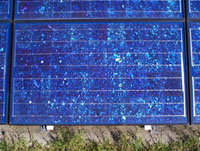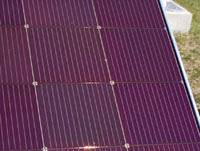Solar Cells
Shedding a little light on
photovoltaics -- 28 February, 2002
|
|
|
|
|
|
|
|
 Figure 3 -- Single crystal solar cells (image courtesy ACRE ) But single crystal silicon isn't the only material used to build solar cells.  Figure 4 -- Polycrystalline solar cells (image courtesy ACRE ) Polycrystalline ("many crystals") solar cells are made by a casting process in which molten silicon is poured into a mould and allowed to cool, then sliced into wafers. This process results in cells that are significantly cheaper to produce than single crystal cells, but whose efficiency is limited to less than 20% due to internal resistance at the boundaries of the silicon crystals.  Figure 5 -- Amorphous solar cells (image courtesy ACRE ) Amorphous cells are made by depositing silicon onto a glass substrate from a reactive gas such as silane (SiH4). This type of solar cell can be applied as a thin film to low cost substrates such as glass or plastic. Thin film cells have a number of advantages, including easier deposition and assembly, the ability to be deposited on inexpensive substrates, the ease of mass production, and the high suitability to large applications. Since amorphous silicon cells have no crystal structure at all, their efficiencies are presently only about 10% due to significant internal energy losses. Aside from the various forms of silicon, a number of other materials can also be used to make solar cells -- gallium arsenide, copper indium diselenide and cadmium telluride to name a few. Note that solar cells are sensitive to different wavelengths of light (i.e., photons of different energies) as a function of the materials they are built from. Accordingly, some cells are better performers outdoors (i.e., optimized for sunlight), while others are better performers indoors (optimized for fluorescent light). Newer, high-tech solar cells have yielded improved energy conversion efficiency by incorporating two or more layers of different materials with different wavelength sensitivities. Top layers are designed to absorb higher energy photons while allowing lower energy photons through to be absorbed by the layers beneath. Double-junction cells are commercially available to BEAMers on occasion (surplus shops often call these "spacecraft cells"). Spacecraft and other mass-sensitive applications have now started to make use of triple-junction cells (but don't expect to find these in surplus shops any time soon). Cell Packaging Now let's move on to the practical issues
involved in using
solar cells. |
|
|
|
|
|
|
|
||
|
|
This page was last updated on |
|